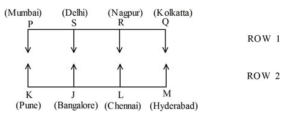Navigating the world of competitive exams, like Bank, SSC, and MBA tests, requires students to learn some very important topics. Among them, “Reasoning Puzzle Questions” and “Seating Arrangement Questions” are two big ones. These questions help test-takers prove their thinking skills in the exams and also improve their general logical abilities.
So, what are “Reasoning Puzzle Questions“? These questions make students think hard and use the given clues to find answers. They challenge the students to connect different pieces of information in a logical way, helping improve their thinking skills.
Now, let’s talk about “Seating Arrangement Questions“. These questions test how well a person can picture and set up information in their mind. They need a lot of focus, patience, and understanding of tricky instructions. They’re key for knowing if a student is good at problem-solving.
Interestingly, many tests mix “puzzle and seating arrangement” together. When we see “puzzles & seating arrangement” in a question, it means students need to use both skills to find the answer. This mix of “puzzle seating arrangement” shows how important these topics are.
There are also other materials like “puzzle questions reasoning” that give more details about the different puzzle types. Some students, while studying these reasoning topics, also look at resources from other subjects, like “puzzle and seating arrangement”, to strengthen their overall skills.
To wrap it up, “Reasoning Puzzle Questions” and “Seating Arrangement Questions” are more than just exam topics. They are crucial skills needed in many job fields. So, learning the details of “puzzle and seating arrangement” is not only for passing exams but also for future career success. Study hard, practice a lot, and use these topics to shine in the world of competitive exams!
Set-61
Twelve persons sitting in two parallel rows, six in each such that they are equidistant from each other. In row 1, B, C, D, E, F, G sits facing South. In row 2, N, O, P, Q, R, S sits facing North. N sits 2nd to the right of S. S sits 3rd to the right of P. O doesn’t faces F. O sits 2nd to the left of S. The person facing O sits to the immediate right of C. Only one person sits between C and E. Two persons sit between B and D. B is not an immediate neighbour of C. Neither C nor B faces R.
1. Who sits 3rd to left of S?
2. What is the position of C with respect to B ?
3. Four of five are alike in a certain way and thus form a group. Which one does not belong to that group?
4. How many persons are there between B and E ?
5. If P faces D in a certain arrangement, then Q faces ?
Set-62
Eight persons P, Q, R & S and J, K, L & M are sitting in two rows namely row 1 & row 2 respectively. Persons in row 1 faces South. Persons in row 2 faces North. Each person in row 1 is facing exactly one person from row 2. Each of the persons are from different places namely Chennai, Mumbai, Hyderabad, Kolkata, Bangalore, Pune, Delhi & Nagpur but not necessarily in the same order. Q sits second to the left of the person, who is opposite to the person from Bangalore. The person from Bangalore is an immediate neighbour of L. L is not from Mumbai, but is an immediate neighbour of the person from Hyderabad. J is not from Hyderabad, but sits opposite to the person from Delhi, who does not sit at any ends. P sits opposite to the person from Pune. R is from Nagpur and is an immediate neighbour of the person from Kolkata. M sits opposite to the person who is an immediate neighbour of R.
6. Which person is from Mumbai ?
7. The person siiting opposite to R is from which place ?
8. K is from which place ?
9. Who sits second to the left of the person from Hyderabad?
10. Four of the five are alike in a certain way, so they form a group. Which one of the following in the below options doesn’t belong to that group ?


